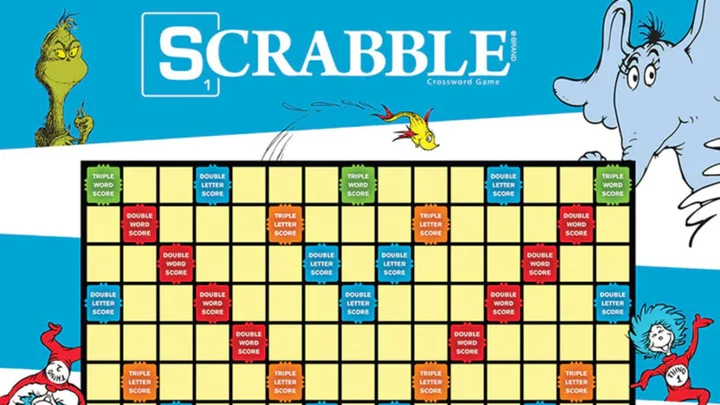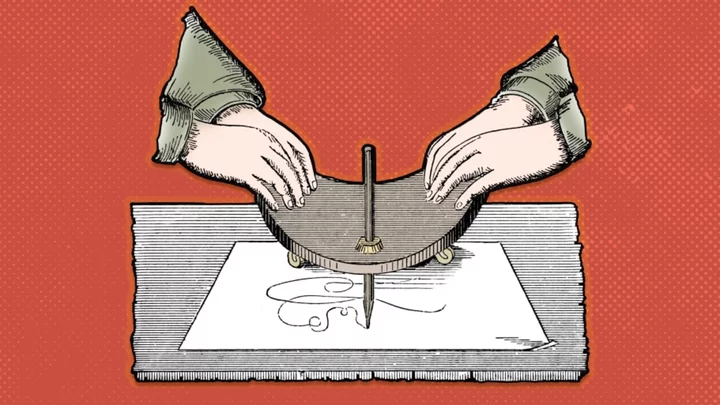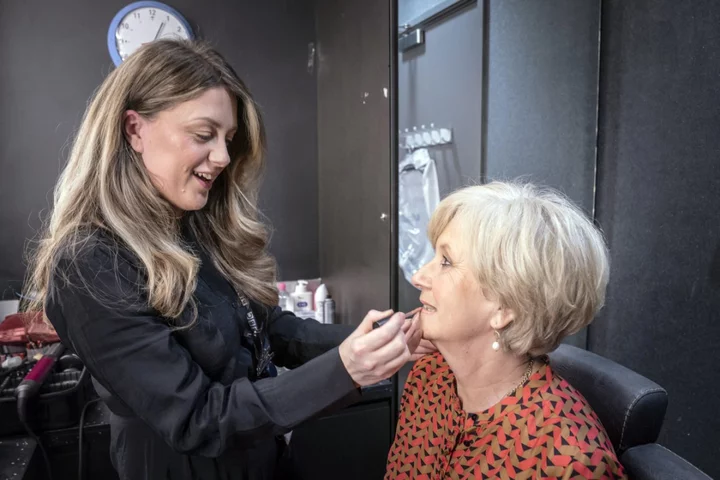
8 Facts About Polar Explorer Roald Amundsen
Roald Amundsen was the first person to reach the South Pole—and that's not all.
1970-01-01 08:00

Rhyming Is Encouraged in the New Dr. Seuss Edition of ’Scrabble’
You can play Dr. Seuss ‘Scrabble’ here or there—you can play it anywhere!
1970-01-01 08:00

Guided by Voices: 7 Books Supposedly Written by Ghosts
From famous authors to a Roman emperor, these spirits sure had a lot to share.
1970-01-01 08:00

Olivia Rodrigo, SZA, Usher, Jelly Roll and more will hit the 2023 iHeartRadio Jingle Ball stage
iHeartRadio has unveiled its star-studded 2023 Jingle Ball lineup, including performances by Olivia Rodrigo, Usher, Nicki Minaj, SZA, Niall Horan, and Jelly Roll
1970-01-01 08:00

US Capital Area Braces for Economic Hit From Government Shutdown
The Washington, DC region is bracing for disruption to the local economy when federal funding lapses at midnight
1970-01-01 08:00

Loewe showcases high-waisted silhouettes in surrealistic Paris fashion display
Flashes of intrigue greeted guests at Loewe’s meticulously designed space for Paris Fashion Week
1970-01-01 08:00

The exact time Brits find themselves ‘uncontrollably hungry’ revealed
One in four Brits find themselves uncontrollably hungry by 10:30 am, research has found. A study of 2,000 adults found they typically snack twice a day, with sausage rolls, crisps, biscuits and bananas the most popular choices. But 27 per cent get the munchies by mid-morning, and a third have even got out of bed for a midnight snack. Other popular treats include chocolate bars, nuts, cake and crackers. A spokesman from Wall’s, which commissioned the research as part of its ‘When hunger calls, grab a Wall’s’ campaign, said: “Sometimes a snack can be an absolute saviour to your day as the research has shown. “Uncontrollable hunger at times can absolutely take over and leave you unable to get on with your day until it’s been satisfied. “And there’s real enjoyment taken from ridding of this hunger whenever it strikes with a snack never being far away.” The study also found 23 per cent of adults don’t usually have breakfast, with 36 per cent of those claiming they are more prone to snacking as a result. When watching TV, over the weekend and in the workplace were the most common times and places to chomp on a treat. And more than £10 is spent on them in a typical week, according to the OnePoll data. More than seven in 10 (73 per cent) have snacks stocked up in their homes for when they need them, and 25 per cent have hidden them from loved ones. While 21 per cent have a dedicated drawer in their workplace for keeping them for when hunger calls. The importance of a snack cannot be underestimated though as 60 per cent believed a great treat can save a rubbish day. To avoid a bad day, 33 per cent will typically pack one for themselves when leaving the house. However, 20 per cent have been made to feel guilty about their snacking habits with others pointing out the frequency they so do. A spokesperson from Wall’s [https://www.instagram.com/wallspastry], added: “Hunger can be overpowering and there’s nothing worse than being caught short and having nothing to hand. “However, there’s no better feeling than finally chomping on something after having been hungry for a while and satisfying that desire. “Snacks such as sausage rolls are a great and versatile option for when hunger calls.” Top 20 most popular snacks, according to Brits: 1. Crisps 2. Biscuits 3. Chocolate bar 4. Banana 5. Nuts 6. Cookies 7. Cake 8. Toast 9. Apple 10. Grapes 11. Crackers 12. Cereal bar 13. Yoghurt 14. Sausage roll 15. Orange/satsuma 16. Cereal 17. Doughnut 18. Berries 19. Flapjack 20. Popcorn Read More Smoking during pregnancy doubles premature birth risk, study finds Four in ten Brits ignore potentially serious eye problems, study finds Study finds women only give themselves 30 minutes of self-care a week Children avoid sleepovers due to fears of wetting the bed Most unwanted gifts people have received The best napping method to help with pulling an all-nighter
1970-01-01 08:00

Man shocked to find out his wife used to date his brother after 20 years of marriage
A man has revealed how he learning his brother used to date his wife of 20 years. In a post to Reddit's "Am I A**hole?" forum, the husband detailed how he found out the earth-shattering news from his sister-in-law at a family dinner. "My (50 ish m) wife (50 ish f) has been married 20+ years. My brother’s (45-ish m) wife (45-ish f) recently disclosed at a family dinner that my brother had a date(s) with my wife several weeks before we started dating. I never knew," he began. "They kept it a secret all these years. I realise it is ancient history, but we have had our marriage issues like every couple over the years. "I feel pain, violated, and almost irrationally angry that this 'secret' was common knowledge in my family, but I was clueless," and added that he is unsure how physical their relationship was but his sister-in-law implied "they were intimate" "My wife and I already sleep apart. I am thinking of ending it with her over this. I was a fool for half my life to everyone close to me. I feel like they are all a**holes. From my parents (who said they thought I knew) to my siblings who all knew, I want no contact (at least for a while)." Since sharing this issue, people have been providing their opinions on the situation with most agreeing that the husband is not the a**hole in this situation but his brother and wife are for keeping this secret all these years. One person said: "NTA but if I heard your story, I would never think that you were the fool or think anything badly of you. I would think badly of all the people who knew but said nothing. So don’t feel like a fool - that would be you letting your insecurities get the better of you." "I think you need to determine if you are upset that they didn't tell you, or upset that she potentially slept with your brother prior to you dating 20 years ago," another person wrote. "You're NTA for being upset regardless, but figuring out the 'why' will help you move forward from here. Don't be so quick to throw 20+ years of marriage down the drain." Someone else added: "Man I don't even know what I would do if my partner slept with my sister and I get to know about it after 20 years.... I would feel embarrassed and betrayed. this sucks." "NTA. The whole family disrespected you and made you feel like a fool. Don’t let them try to minimize your feelings," a fourth person commented. "It’s not one lie from 20 years ago. It’s hundreds of lies by omission at every holiday, every wedding, every funeral, every family dinner." Sign up to our free Indy100 weekly newsletter Have your say in our news democracy. Click the upvote icon at the top of the page to help raise this article through the indy100 rankings.
1970-01-01 08:00

National Park Closures in Shutdown Could Ignite Partisan Feuding
The Grand Canyon. Joshua Tree. The Great Smoky Mountains. America’s 85-million-acre National Park System houses some of the
1970-01-01 08:00

A new Spanish law strengthens animal rights but exempts bullfights and hunting with dogs
A new animal welfare law in Spain outlaws the use of animals for recreational activities that cause them pain and suffering but allows bullfights and hunting with dogs
1970-01-01 08:00

This is how your make-up needs change as you age
Whether you’re in your 30s or your 60s, your skin probably doesn’t look and feel like it did at the age of 20 – and that’s OK. But if you’ve barely upgraded the make-up you’ve been using for years, it might be time to do so. “As we age, our skincare and make-up needs change, and it’s important to adapt our beauty routines to address the specific concerns that come with each decade,” says Co. Kildare-based make-up artist Suzie O’Neill, owner of vegan cosmetics company Ayu. Over time, your skin loses elasticity and oils, so in all age groups solid skincare is key. “Regardless of age, a good skincare routine is essential for a smooth make-up application,” O’Neill says. “Prioritise moisturising and using sunscreen daily.” She advises using products rich in vitamins A, C and E – to protect the outermost layer from water loss in your 30s, a decade where “skin becomes more delicate and cell turnover is slowing down, making your complexion look dull”. So how should we switch up our make-up in our 40s and beyond? In your 40s Collagen and elastin production naturally decrease during this period, leading to a reduction in skin firmness and elasticity in your 40s, O’Neill says. To combat this, she recommends incorporating a serum with ingredients like hyaluronic acid, peptides and retinol, which can help stimulate collagen production. Foundation is the most important make-up upgrade to make at this period of your life. “Your 40s are the ideal time to switch to a foundation that is more hydrating and lighter than what you might have used in your 20s and 30s. Heavy, matte foundations tend to settle into fine lines and wrinkles, which can accentuate them. A hydrating and lighter foundation is a better choice as your skin may become drier and more mature.” O’Neill advises using a moisturising lipstick or balm to keep lips hydrated, as they can start to become drier at this time in our lives. “The cumulative effects of sun exposure can become more apparent in your 40s, leading to pigmentation issues, fine lines and potential sunspots,” she adds. So a broad-spectrum sunscreen is “non-negotiable”. In your 50s When it comes to make-up, your 50s may be a time when you opt for a more natural look. “A light to medium coverage foundation or a tinted moisturiser [will] not only provide a subtle, youthful glow, but also allow the natural character of the skin to shine through,” notes O’Neill. “Less is often more at this stage.” She recommends focusing on techniques that lift and brighten the eyes. “For example, tight-lining – applying eyeliner to the upper waterline – can make lashes appear thicker and eyes more prominent. Apply eye make-up with a light hand and choose softer, neutral shades that open up the eyes and give them a more refreshed appearance.” It’s common for lips to appear to lose volume by our 50s, so O’Neill suggests using a lip liner in a shade closely matching your natural lip colour. “It can work wonders by creating the illusion of fuller, more voluptuous lips. “Eyebrows and eyelashes tend to thin out as we age; filling in sparse brows with a brow pencil or powder and using volumising mascara can help restore the appearance of full, youthful brows and lashes.” In your 60s and beyond As you enter your 60s, you could opt for warmer hues. “As our skin naturally loses some of its warmth and pigmentation, opting for a foundation with warmer undertones can help counteract any sallowness that may occur,” says O’Neill. “[But] choosing a foundation that matches your skin tone as closely as possible is essential.” You also might notice an increase in pigmentation irregularities on your skin. “To even out pigmented skin, I’d recommend using a colour-correcting concealer for spots and discolourations (orange or peach-toned concealers can help neutralise dark spots) followed by a lightweight foundation or BB cream to even out skin tone,” she says. “Use setting powders sparingly as they can emphasise fine lines. Opt for a finely milled, translucent powder applied lightly only where needed.” And don’t be afraid to experiment with colour in your 60s. “Using more colour can be a great way to combat dullness that often accompanies ageing skin. “Brighter shades of make-up, such as lipsticks, eyeshadows, and blush, can help liven up your complexion.” Blush can help brighten up your skin, with O’Neill recommending cream versions as “they tend to blend more seamlessly and provide a dewy, hydrating finish”, and can be easily applied with your fingers. “Just remember to choose shades that complement your skin tone and apply them sparingly for a natural flush,” she adds. As you age, splurging on make-up isn’t a must, she says, but investing in high-quality make-up products that cater to your specific needs can be beneficial. “Look for products that provide essential hydration [and] achieve a luminous glow. “The key is to enhance your natural beauty rather than mask it.” Read More Charity boss speaks out over ‘traumatic’ encounter with royal aide Ukraine war’s heaviest fight rages in east - follow live Victorian dahlia show recreated at Stonehenge with thousands of flowers Daily activities could help lower heart attack risk, study suggests From tiredness to sweating – subtle warning signs something could be wrong with your heart
1970-01-01 08:00

Daily activities could help lower heart attack risk, study suggests
Everyday activities like walking up the stairs or playing with children could help lower the risk of heart attack, stroke and even premature death, new research suggests. The experts found that although short bouts of incidental activity are good for you, the how long you do them for, and how vigorously makes a difference. The findings may make physical activity much more accessible to people who are unwilling or unable to take part in structured exercise, researchers say. They found that the longer the bouts of activity, the better, regardless of total activity levels. The large majority (97%) of this everyday physical activity, like walking to the bus stop or household chores, was made up in bouts lasting less than 10 minutes. In a group of people who said they did not take part in exercise or sport, short bouts of less than 10 minutes at a moderate to vigorous intensity were associated with a steep decrease in heart attack and stroke, and death by any cause. According to the findings, moving consistently for at least one to three minutes was linked to significantly more benefit (29% lower) than very short bouts of movement that lasted less than one minute. Senior author Professor Emmanuel Stamatakis from the University of Sydney’s Charles Perkins Centre, in Australia, said: “From walking up the stairs to speedily mopping the floors, in recent years we’ve come to understand that it is not just structured exercise that is good for our health, but we know very little about how these short bouts of incidental activity translate to health benefits.” He added: “The take-home message here is any type of activity is good for your health, but the more effort you put into those daily tasks and the longer you keep up that energy, the more benefits you are likely to reap. “If you are huffing and puffing and unable to hold a conversation for some of that time you have hit the sweet spot.” Lead author Dr Matthew Ahmadi said: “The idea of accruing short bouts of moderate to vigorous activity through daily living activities makes physical activity much more accessible to people who are unwilling or unable to take part in structured exercise. But as we see in this data, the length and the vigour people put into these incidental activities matters.” The risk of all-cause death and major cardiovascular events (heart attack or stroke) was 29-44% lower for activity periods of five minutes to less than 10 minutes, than bouts of less than one minute. The study, published in The Lancet Public Health, also found that the higher the amount of vigorous activity in each bout the better. People who huffed and puffed for at least 15% of the activity period (10 seconds per minute) saw the greatest benefit. Bouts of less than one minute were also associated with benefits if the above 15% vigorous activity rule was applied, researchers found. The researchers used data from wrist devices worn by 25,241 people aged 42 to 78, in the UK Biobank database, and artificial intelligence to analyse the seven-day physical activity patterns in people who said they did not exercise. The study linked these physical activity patterns with health records, following people for close to eight years to identify how length and intensity of physical activity bouts were linked to health status. Dr Ahmadi added: “This study suggests people could potentially reduce their risk of major cardiac events by engaging in daily living activities of at least moderate intensity where they are ideally moving continuously for at least one to three minutes at a time. “In fact, it appears that this can have comparable health benefits to longer bouts lasting five to 10 minutes.” Read More Charity boss speaks out over ‘traumatic’ encounter with royal aide Ukraine war’s heaviest fight rages in east - follow live From tiredness to sweating – subtle warning signs something could be wrong with your heart Breast Cancer Awareness Month: 9 brilliant beauty buys supporting good causes Smokers 2.6 times more likely to give birth prematurely
1970-01-01 08:00
